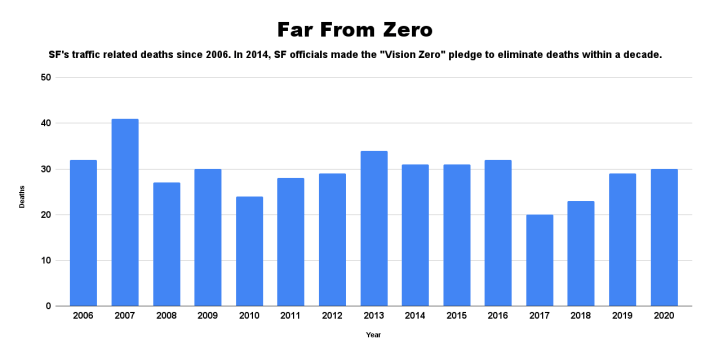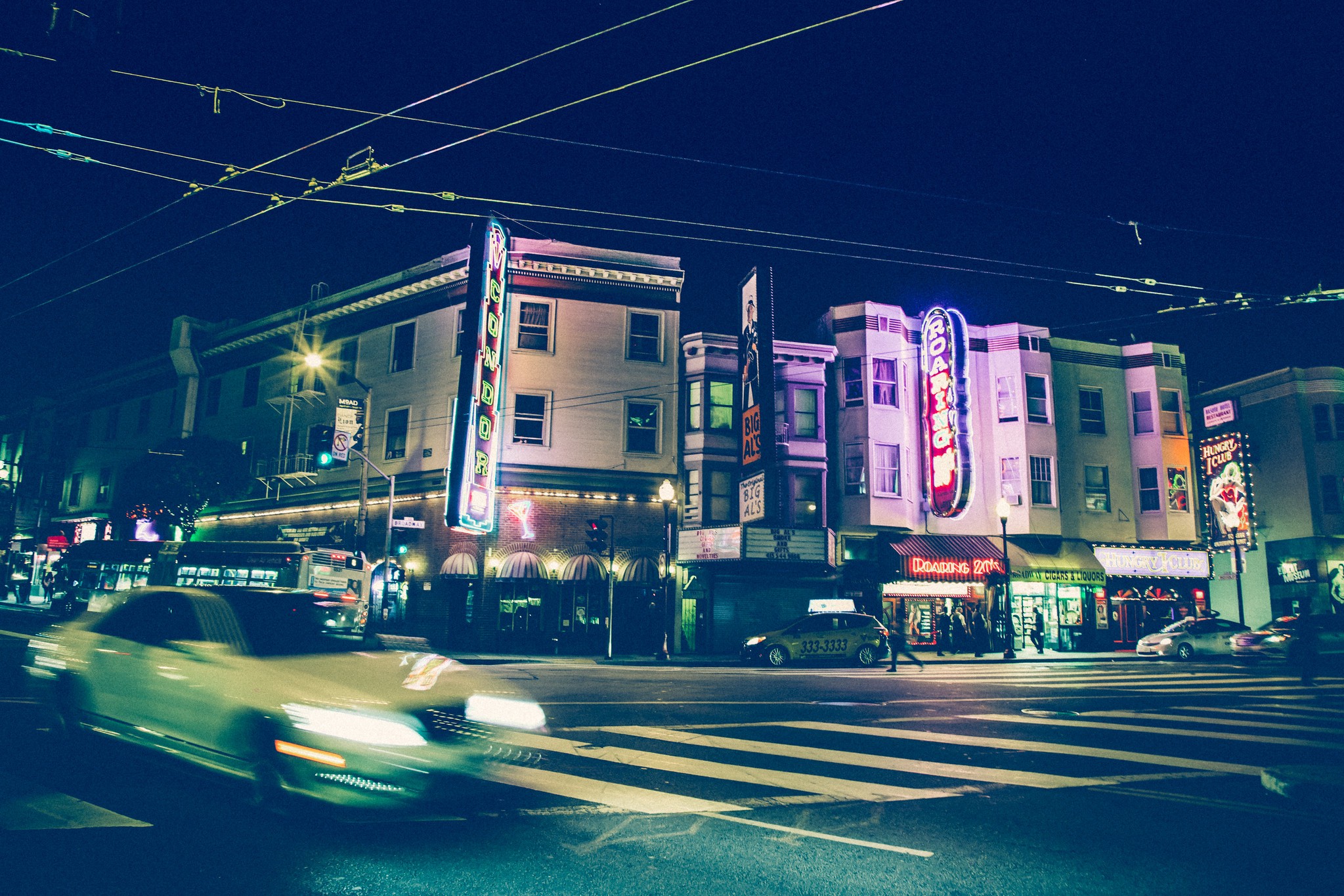This article first appeared in the Frisc and is reprinted with permission.
Despite a long-standing pledge to eliminate traffic deaths by 2024, San Francisco has made no progress toward this goal, and has received little support from state lawmakers who hold sway over the city’s street rules.
One of SF’s representatives in Sacramento has tried in vain to make big changes. Will his latest attempt fare better?
Earlier this year, AB 550 — a bill championed by Assemblymember David Chiu to pilot the use of speed cameras in six cities, including San Francisco — became a beacon of hope for advocates who want to slow drivers down and save lives.
Speed kills: In 2019, speeding was a factor in 26 percent of traffic fatalities, according to the National Highway Traffic Safety Administration. In California, speeding drivers cause an estimated 1,000 traffic deaths each year.
As for San Francisco, 30 people died in collisions in 2020, despite a decrease in traffic due to the pandemic. The 30 deaths were a 3% increase from the year before, and 11% above the annual average since 2014, the year city leaders vowed to eliminate traffic fatalities.

In 2021, 13 people already have been killed in car collisions, a majority of them pedestrians.
But the bill, which was Chiu’s second attempt at automated cameras in high collision areas, unexpectedly died in committee in May, leaving advocates — and Chiu himself — shocked.
“I was heartbroken when we didn’t get AB 550 out of [the] Assembly Appropriations [Committee], but that fight will continue,” the San Francisco legislator said.
Back for more
Now state lawmakers are back with another proposal that tackles the speeding problem from a different angle. Unlike the doomed AB 550, AB 43 last week cleared a big hurdle — the Senate Transportation Committee — and is heading to a hearing in the Senate Appropriations Committee next month.
Authored by Assemblymember Laura Friedman of Glendale and coauthored by Chiu, AB 43 would give Caltrans and local jurisdictions more power to set speed limits — especially in areas with vulnerable pedestrian groups such as seniors, children, people with disabilities, and the unhoused.
“In recent years, study after study has confirmed and reconfirmed how speed kills and how these policies can make an enormous difference,” Chiu told The Frisc one day after the bill cleared the transportation committee. Studies show that lowering a posted limit even by 5 mph can greatly reduce serious pedestrian injuries and deaths.
“In the age of online telephone apps like Waze and Google Maps, you have a lot of people driving through neighborhoods that they’re unfamiliar with trying to get to and from work and often speeding,” Friedman said at last week’s hearing.
AB 43 would create exceptions to a longtime (some would say archaic) traffic policy rule. To set speed limits, California currently relies on the 85th percentile method, which sets the limit on any given street at the speed at which 85 percent of traffic is moving. The standard, developed in the middle of the last century and used across the country, can in fact force cities to raise speed limits to accommodate fast drivers. There’s a rising clamor across the country to ditch it.
“[It] assumes most drivers will drive at a safe and reasonable speed based on the road conditions,” according to a 2020 report from a California state traffic fatalities task force. “It is also based on the idea that speed limits are safest when they conform to the natural speed driven by most drivers, and that uniform vehicle speeds increase safety and reduce risks for crashes.”
Chiu told The Frisc that he’s hopeful AB 43 will pass. During his 12 years of public service, he has seen “more people understand how important it is for us to grapple with these issues, and how avoidable these incidents of traffic violence are if we have smart transportation policy.”
Ambition, meet reality
While Chiu, Friedman, and other state legislators work to get AB 43 to the governor’s desk, San Francisco’s Vision Zero Task Force, which includes transportation and public health officials and community members, is finalizing a draft of a three-year plan to reduce the city’s street deaths. Some traffic safety advocates, though, say it isn’t bold enough to reach the original goal of zero deaths by 2024.
“The pace and the aggressiveness is not what it needs to be to really move the needle,” Marta Lindsey, communications director of pedestrian advocacy group Walk SF, told The Frisc.
The draft includes a host of ideas such as a comprehensive speed management plan, the installation of more than 100 traffic calming devices per year, and potential expansion of the no-turn-on-red restrictions approved in the Tenderloin earlier this year.
To Lindsey, the goal of 100-plus calming devices per year, which often take the form of quickly installed bollards and painted zones to protect pedestrians and bikers, is typical of the city’s sluggish pace. (Another example is the Municipal Transportation Authority’s recent initiative to install left-turn calming devices at a grand total of seven intersections.)
Measures to slow cars making turns have shown results in other cities like Portland and New York, which saw a 20 percent decrease in pedestrian injuries. “Let’s go bigger when you have something that has a lot of promise,” Lindsey said.
When asked about criticism from bike and pedestrian advocates that the city’s “quick build” program isn’t moving fast enough, even with positive data in hand, SFMTA spokesperson Erica Kato didn’t respond to the issue directly, but emailed a list of the agency’s efforts since 2019 — including “10 new transit boarding islands, over 86 painted safety zones, and more than 12 miles of new or improved bikeways, among many other traffic safety improvements.”
One problem is that the city’s ambitions often fall short. Nesrine Majzoub, communications director at the SF Bicycle Coalition, said that while the city has dreamt up bold projects, many of them have been “watered down.”
For example, a dramatic transformation of Market Street had been more than 10 years in the making when the Board of Supervisors approved the project and its $604 million price tag in October 2019. The plans included wider sidewalks, fully protected bike lanes, a ban on cars, and transit-only lanes. Citing pandemic budget woes, however, supervisors downsized plans for Market, which included merging bikes back into traffic, much to bike advocates’ disappointment.
“I do think that there is frustration, and I think along with that, there’s heartbreak,” Majzoub noted. “It shouldn’t be unsafe to walk a few blocks to go somewhere or take a bike ride somewhere in our city.”
As San Francisco has battled through the pandemic, some residents have used the last year and a half as an opportunity to reimagine the streetscape.
Last April, the city began closing certain residential streets to through traffic to give people more space to social distance and exercise. At least 28 corridors received the temporary slow street treatment. The first test of making the changes permanent centers on Page, Sanchez, and Shotwell streets.
Plans to close the Great Highway and Golden Gate Park’s JFK Drive have already run into opposition.
But Chiu said he has seen a steady shift among his local constituents. “It’s almost like every two weeks, another grassroots activist will reach out wanting support on changes in roadways in their neighborhood,” he recounted. “I know that these folks are working together, reaching across neighborhood and city lines to make our community safer and more liveable.”
***
Grace Hase is a Bay Area-based freelance journalist. She previously worked as a reporter for Metro Silicon Valley/San Jose Inside, where she covered San Jose City Hall, transportation, housing policy, and the COVID-19 pandemic. Grace holds a bachelor of arts in political science and a bachelor of journalism in investigative reporting from the University of Missouri-Columbia.





